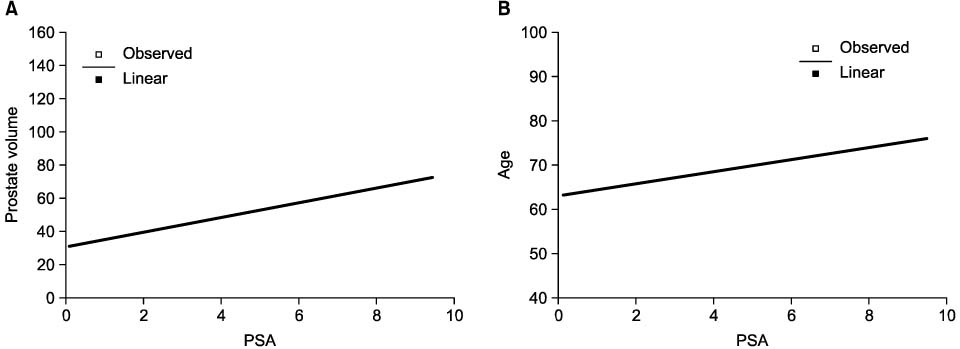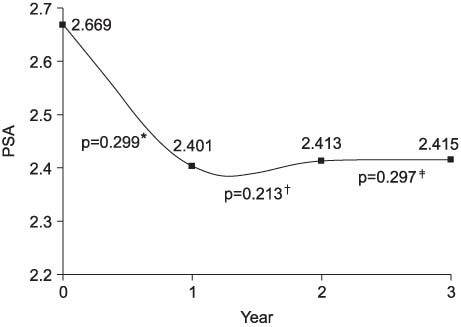Korean J Urol.
2006 Apr;47(4):372-376. 10.4111/kju.2006.47.4.372.
The Changing Pattern of Serum Prostate Specific Antigen in Patients with Benign Prostatic Hyperplasia after Combined Treatment with Finasteride and alpha-blockers: the 3 Year Follow-up Data
- Affiliations
-
- 1Department of Urology, Urological Science Institute, Yonsei University College of Medicine, Seoul, Korea.
- KMID: 1997145
- DOI: http://doi.org/10.4111/kju.2006.47.4.372
Abstract
- PURPOSE
Some recent studies have demonstrated that finasteride, a well- known 5alpha-reductase inhibitor, can decrease prostate specific antigen (PSA) by approximately 50% during the first 1 year of treatment. We investigated how long-term treatment with finasteride and alpha-blockers impacts on the serum PSA level of men whose final diagnosis was benign prostatic hyperplasia (BPH).
MATERIALS AND METHODS
In a retrospective trial, we evaluated a total of 293 men with lower urinary tract symptoms (LUTS) that were suggestive of BPH. These men were divided into two treatment groups: group A was treated with alpha-blockers and group C was treated with a combination of finasteride and alpha-blocker. Comparisons of the two groups were performed by using independent t-tests. The changes in the PSA concentrations from baseline to the time of the final measurements were determined by repeated measures of ANOVA.
RESULTS
There was no significant difference in the baseline PSA between the two groups. A statistically significant reduction in the PSA levels was observed at 2 years in C group (p<0.05), whereas any significant increase were not observed in group A (p>0.05). In group A, the repeatedly measured PSA levels were 2.67, 2.40, 2.41 and 2.42, respectively. In C group, these were 3.22, 2.09, 1.81 and 1.71 respectively.
CONCLUSIONS
Our data showed that there was no clinically significant effect of long term treatment with alpha-blocker on the PSA levels. However, finasteride had significant effect on the serum PSA level during first two years of treatment.
MeSH Terms
Figure
Reference
-
1. Thorpe A, Neal D. Benign prostatic hyperplasia. Lancet. 2003. 361:1359–1367.2. Holtgrewe HL, Mebust WK, Dowd JB, Cockett AT, Peters PC, Proctor C. Transurethral prostatectomy: practice aspects of the dominant operation in American urology. J Urol. 1989. 141:248–253.3. Mebust WK, Holtgrewe HL, Cockett AT, Peters PC. Transurethral prostatectomy: immediate and postoperative complications. A cooperative study of 13 participating institutions evaluating 3,885 patients. J Urol. 1989. 141:243–247.4. Caine M. Alpha-adrenergic mechanisms in dynamics of benign prostatic hypertrophy. Urology. 1988. 32:6 Suppl. 16–20.5. Stoner E. The Finasteride Study Group. The clinical effects of 5alpha-reductase inhibitor, finasteride, on benign prostatic hyperplasia. J Urol. 1992. 147:1298–1302.6. Souverein PC, Erkens JA, de la Rosette JJ, Leufkens HG, Herings RM. Drug treatment of benign prostatic hyperplasia and hospital admission for BPH-related surgery. Eur Urol. 2003. 43:528–534.7. Stoevelaar HJ, McDonnell J. Changing therapeutic regimens in benign prostatic hyperplasia. Clinical and economic considerations. Pharmacoeconomics. 2001. 19:131–153.8. Oesterling JE. Benign prostatic hyperplasia. Medical and minimally invasive treatment options. N Engl J Med. 1995. 332:99–109.9. Lepor H, Williford WO, Barry MJ, Brawer MK, Dixon CM, Gormley G, et al. Veterans Affairs Cooperative Studies Benign Prostatic Hyperplasia Study Group. The efficacy of terazosin, finasteride, or both in benign prostatic hyperplasia. N Engl J Med. 1996. 335:533–539.10. Wang MC, Valenzuela LA, Murphy GP, Chu TM. Purification of a human prostate specific antigen. Invest Urol. 1979. 17:159–163.11. Guess HA, Heyse JF, Gormley GJ, Stoner E, Oesterling JE. Effect of finasteride on serum PSA concentration in men with benign prostatic hyperplasia. Results from the North American phase III clinical trial. Urol Clin North Am. 1993. 20:627–636.12. Cho SH, Lee SK. The experience with combination of finasteride and tamsulosin on benign prostatic hyperplasia. Korean J Urol. 2003. 44:1110–1114.13. Chon JK, Borkowski A, Partin AW, Isaacs JT, Jacobs SC, Kyprianou N. Alpha1-adrenoceptor antagonists terazosin and doxazosin induce prostate apoptosis without affecting cell proliferation in patients with benign prostatic hyperplasia. J Urol. 1999. 161:2002–2008.14. Kyprianou N, Litvak JP, Borkowski A, Alexander R, Jacobs SC. Induction of prostate apoptosis by doxazosin in benign prostatic hyperplasia. J Urol. 1998. 159:1810–1815.15. Glassman DT, Chon JK, Borkowski A, Jacobs SC, Kyprianou N. Combined effect of terazosin and finasteride on apoptosis, cell proliferation, and transforming growth factor-beta expression in benign prostatic hyperplasia. Prostate. 2001. 46:45–51.16. Milam D, Oesterling JE, Roehrborn CG, Auerbach S, Padley RJ. Serial prostate-specific antigen measurements in patients with clinical benign prostatic hyperplasia enrolled in a randomized, double-blinded, placebo-controlled study with terazosin. J Urol. 1995. 153:Suppl. 396A.17. Jones EA, Ploch NR, Brawer MK. Serum PSA in men with symptomatic BPH treated with terazosin. J Urol. 1994. 151:Suppl. 510A.18. Brown JA, Peterson DD, Lieber MK, Oesterling JE. Terazosin and finasteride both lower the serum prostate-specific antigen (PSA) level in men with benign prostatic hyperplasia (BPH). J Urol. 1996. 155:Suppl. 424A.19. Roehrborn CG, Oesterling JE, Olson PJ, Padley RJ. HYCAT Investigator Group. Hytrin Community Assessment Trial. Serial prostate-specific antigen measurements in men with clinically benign prostatic hyperplasia during a 12-month placebo-controlled study with terazosin. Urology. 1997. 50:556–561.20. Brawer MK, Lin DW, Williford WO, Jones K, Lepor H. Effect of finasteride and/or terazosin on serum PSA: results of VA Cooperative Study #359. Prostate. 1999. 39:234–239.21. Vaughan D, Imperato-McGinley J, McConnell J, Matsumoto AM, Bracken BR, Roy J, et al. Long-term (7 to 8-year) experience with finasteride in men with benign prostatic hyperplasia. Urology. 2002. 60:1040–1044.
- Full Text Links
- Actions
-
Cited
- CITED
-
- Close
- Share
- Similar articles
-
- The Influence of Prostate Volume on the Serum Prostate-specific Antigen Levels and the Percentage of the Free Prostate-specific Antigen Levels during Finasteride Medication
- The Different Reduction Rate of Prostate-Specific Antigen in Dutasteride and Finasteride
- Effect of Finasteride on Free/Total Serum PSA Ratio in Patients with Benign Prostate Hyperplasia
- Change of PSA Density after Finasteride Therapy in Patients with Benign Prostatic Hyperplasia
- Assessing the Effect of Finasteride by Prostate Tissue Composition




